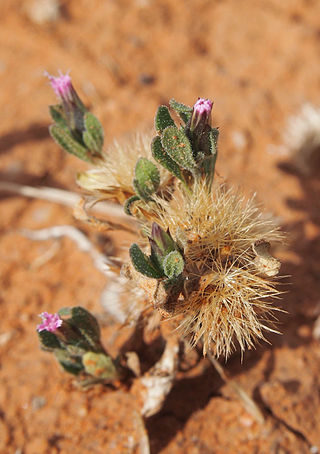
Ranunculus repens, the creeping buttercup, is a flowering plant in the buttercup family Ranunculaceae, native to Europe, Asia and northwestern Africa. It is also called creeping crowfoot and sitfast.

Rutidosis leptorrhynchoides, commonly known as button wrinklewort, is a flowering plant in the family Asteraceae. It is an upright, tufted, perennial herb with bright green leaves and yellow button-shaped flowers.

Scaevola hookeri, commonly known as the creeping fan-flower or alpine fan-flower, is a species of flowering plant in the family Goodeniaceae. It has white or blue flowers with a yellow throat and grows in eastern Australia.

Ranunculus papulentus, commonly known as the large river buttercup, is a buttercup that is endemic to south-eastern Australia.

Actinotus minor, commonly known as the lesser flannel flower, is species of flowering plant in the family Apiaceae and is endemic to New South Wales. It is a small, sprawling plant with grey-green leaves and white flowers.

Stackhousia monogyna, commonly known as creamy stackhousia or creamy candles,is a flowering plant in the family Celastraceae. It is a small multi-stemmed plant with narrow leaves and terminal spikes of white, cream or yellow flowers. It is a widespread species found in all states of Australia but not the Northern Territory.
Ranunculus allenii, commonly known as Allen's buttercup, is a flowering plant in the crowfoot or buttercup family, Ranunculaceae. Generally found in wetlands in northern latitudes, it bears yellow flowers in summer, which are pollinated by insects.

Solanum cinereum, commonly known as Narrawa burr, is a species of flowering plant in the family Solanaceae. It has dark green, spiny leaves and purple flowers and grows in open woodland in south eastern Australia.

Brachyscome graminea, commonly known as grass daisy, is a perennial herb in the family Asteraceae and is endemic to Australia. It has mostly mauve-pink or purple daisy-like flowers and a yellow centre.

Brachyscome nivalis, commonly known as snow daisy, is a perennial herb in the family Asteraceae and is endemic to Australia. It has mostly white daisy-like flowers, yellow centres and deeply lobed leaves.

Senecio linearifolius, commonly known as fireweed groundsel, is a species of flowering plant in the family Asteraceae. It is a small shrub with variable leaves, numerous heads of yellow flowers and grows in Tasmania, New South Wales and Victoria.

Hovea purpurea, commonly known as velvet hovea, is a flowering plant in the family Fabaceae. It is an upright shrub with narrow leaves, purple pea flowers and stems with matted hairs. It grows in New South Wales, Victoria and South Australia.

Calotis lappulacea, commonly known as the yellow burr-daisy, is a flowering plant in the family Asteraceae found in many parts of mainland Australia. It is a small, perennial herb with yellow globular flower-heads.

Streptoglossa adscendens, commonly known as desert daisy, is a species of flowering plant in the family Asteraceae and grows in all mainland states of Australia with the exception of Victoria. It is a ground cover, upright or ascending perennial or annual herb with purple or pink flowers.

Pelargonium inodorum, commonly known as wild pelargonium, is a flowering plant in the family Geraniaceae. It is grows in New South Wales, Queensland, Tasmania, Victoria, New Zealand. It has scented leaves and mostly pink flowers.

Vittadinia muelleri, commonly known as narrow-leaf New Holland daisy, is a flowering plant in the family Asteraceae. It is a small perennial forb with bright green leaves and purple daisy-like flowers. It grows in New South Wales, Victoria, Tasmania and the Australian Capital Territory.

Podolepis decipiens, commonly known as deceiving copperwire-daisy, is a flowering plant in the family Asteraceae and grows in Victoria, Tasmania and New South Wales. It is an upright, perennial herb with yellow daisy-like flowers on a single stem rising from a sparse rosette.

Coronidium monticola, commonly known as the mountain coronidium, is a flowering plant in the family Asteraceae and grows in open forests in eastern Australia. It has woolly, grey-green leaves and mostly yellow flowers.

Calocephalus lacteus, commonly known as lemon beauty-heads, is a species of flowering plant in the family Asteraceae. It has yellow cylindrical shaped flowers and grey stems and grows in the eastern states of Australia

Brachyscome spathulata, commonly known as spoon-leaved daisy, is a flowering plant in the family Asteraceae. It has dark green leaves, mauve daisy-like flowers and grows in New South Wales, Tasmania, Victoria and the Australian Capital Territory.



















